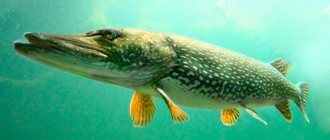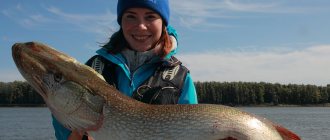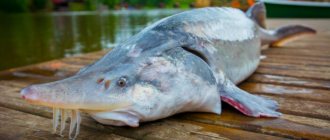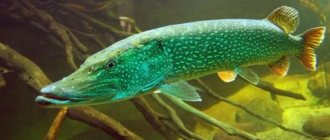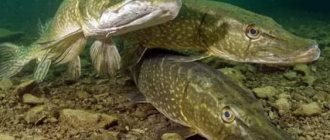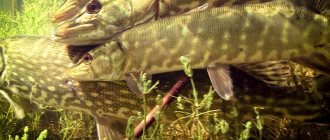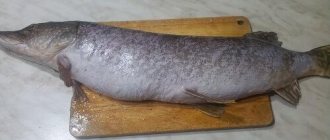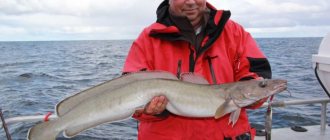Some scientific information
Any student knows that pike is a river predatory fish and can grow to enormous sizes. In addition, scientists have long studied the habitat, external and internal structure, food preferences and fishing characteristics of the toothed predator. In accordance with the classification in the biology textbook, pikes belong to the animal kingdom, the phylum of chordates, the class of ray-finned animals, and the order of pike-shaped animals. Pike are freshwater fish. The body of the river predator is elongated, and the mouth has many sharp teeth, while the lower jaw protrudes significantly forward. Scientists have found that pike live on average more than 30 years, and its growth continues throughout its life. Fish can reach simply enormous sizes. The size of pike in a quiet backwater can reach 2 meters in length, and the weight of such a fish is 30-35 kg. The predator loves quiet muddy pools and calm bodies of water, so biologists do not recommend swimming in forest ponds. Where are pike found? The habitat of this fish is Europe, Siberia and even North America.
Body color
The body color of a pike greatly depends on its habitat. The back is dark, closer to black. The sides are much lighter with small olive-colored spots that form stripes, allowing the predator to perfectly camouflage itself in grass and snags. Pike living in the depths have a darker body color than fish living in shallow water. The toothy predator is capable of changing the color of its body depending on the objects around it. The color change occurs over a large period of its life, so it is not appropriate to compare it with a flounder or a chameleon.
Scales
Pike scales cover the entire body of the fish, from the gill covers to the tip of its tail. Not large, very dense scales are covered with abundant mucus.
Dorsal fins
The dorsal fin of the pike is located closer to the tail above the anus. The color of the dorsal fin depends on the habitat of the fish and is mostly gray-green, and sometimes brown-orange.
Pectoral and anal fins
The pectoral fins are brightly colored in red-orange tones, less often in gray-green. The anal fins are the same color, but have brown spots.
Head and teeth
The pike's head is elongated with a strongly protruding lower jaw. The pike's teeth on the lower jaw have the shape of fangs and are of different sizes; this structure allows the predator to easily capture prey. The upper jaw is strewn with small, very sharp, razor-like teeth directed inside the head, which minimizes the victim’s chances of breaking free.
In the lower jaw of the pike, next to the fangs, there are replacement teeth, usually 2-3. If the main canines break or wear out, replacement teeth take their place, and the old teeth that have lost their functionality die and fall out. This is the period of life when the pike changes its teeth.
Due to the uneven change of teeth, the pike’s mouth simultaneously contains replacement teeth, working fangs and dying old teeth.
Fantasy runs wild...
Fishing is a fun and exciting activity that men and women, children and old people, boys and girls love to do. At the same time, every fisherman has several dozen stories about a lost catch or a giant fish he caught. In order for a large pike to easily fall on a fisherman’s hook, you need to select the appropriate equipment, purchase bait and choose the optimal place for fishing.
Many fishermen were lucky enough to catch pike up to 1 meter long and weighing more than 15 kg. However, there are many fishing stories that tell of larger catches. The giant pike is the main character of such stories.
They ringed the predator and found out her age
There are truly fantastic stories and stories about the largest pikes. According to one popular legend, a giant pike was caught in Germany in 1497, and its weight was 140 kg. The length of the toothy predator exceeded 5.5 meters, and the age of the fish was 270 years. How did you find out the age of the pike? Everything is very simple - in 1230, by order of the Emperor of the Roman Empire, Frederick II, a special ring with a date was put on the river predator. It was from the ring that scientists were able to determine the age of the fish. The skeleton of a giant pike was placed in a museum in Mannheim, where it was an exhibit for several years. Eyewitnesses claim that all the scales of the pike were white. Due to age, all melanin has completely disappeared from the fish’s body. Subsequently, biologists examined the skeleton and found that the giant pike was assembled from the bones of several fish. Thus, the story about the huge predator did not receive scientific confirmation and became a fishing fiction.
Reproduction and offspring
How to determine the age of a cow from a photo's horns?
Pike are actively breeding. The predator's fertility is up to 200 thousand eggs 3 mm in diameter. The ideal depth for spawning can be from 0.5 to 1 m in places with sparse algae thickets. When spawning, the female lays eggs, and several males, following her, water her with milk.
The eggs attach to the plants, and then fall off and lie on the bottom of the reservoir. It takes 8-14 days for the fry to develop. At first, their diet includes small crustaceans, later - fry of other fish. Puberty of pikes occurs at 2-4 years.
River pike, 2 weeks after spawning, makes forays into fast water to shallow riffles. When casting in shallow water, you must immediately reel in the line at a given pace so that the nozzle does not become clogged with plant debris.
The success of fishing with “dirty” live bait decreases significantly. The main trophy during the spring pike feast is individuals up to 2 kg. Large ones are found less often than in August and September.
How to distinguish a male from a female
The male differs from the female in the type of urogenital opening. In males it looks like an oblong slit, and in females it looks like a depression. Male pike are smaller in size and have a more slender body than females.
How many times a year does spawning occur and at what time?
Spawning time is spring (from early March to May). The ability to reproduce occurs by 2-3 years, when the body length reaches 30-35 cm. Spawns at a fairly low temperature (4-6 ⁰C).
On the approaches to spawning grounds, at a depth of 0.5-1 meters, clusters of fish form, and there are usually several males around one female.
not allowed during the spawning period from March 1 to April 15−25. In Belarus even earlier - at the very beginning of March. The timing and timing of spawning depend on the climate and region where the fish live.
The warmer the water, the faster the process occurs. The optimal water temperature for pike spawning is 5-7 degrees.
A group consisting of one female and several males constantly moves around the spawning area. It often happens that in those reservoirs where wastewater is discharged, eggs die.
After spawning, the pike recovers for about a week, actively absorbing food. To restore strength, she needs to actively eat. It is during this period that you can actively hunt for a predator, since it is ready to grab any bait.
Zhor after spawning occurs at the end of April-May. This period is considered by fishermen to be the most successful for hunting predators.
But during the spawning period, catching is prohibited. Violation of the ban will result in the payment of a substantial fine (up to 300 thousand rubles). The ban is being introduced specifically to prevent the population of this valuable fish from being limited.
What does a pike fry look like and what is it called?
or “little puppy” is green at first and looks like its little parents. But after a year, the squinting becomes gray in color with characteristic spots on the body. Children of pike are characterized by a size of up to 20 cm and a weight of up to 1 kg. They are caught from August until late autumn.
How many years does he live?
Pike lives on average 7 years. The maximum age of pike in commercial catches does not exceed 20 years. There is also information in the media about the capture of a 33-year-old pike.
How to determine age by weight and size
Usually the age of a pike is determined by the annual rings on its scales. You can accurately determine the age only by dissecting the pike's head and examining its bones. This is mostly done by professionals, since it is very easy to make a mistake.
It is believed that if a pike is small - 25-35 cm, then it is no more than 1-2 years old. If a predator reaches a meter, its age can be very large, including up to 20 years.
How are things in Russia?
In our country there is an equally interesting legend about a giant river predator. History says that when cleaning the Tsar's ponds in 1794, fishermen managed to catch a huge fish. The giant pike was ringed with a gold ring, while the mark of the Russian Tsar Boris Fedorovich was clearly visible on it. The length of this river predator almost reached 2 meters, and its weight exceeded 60 kg. Judging by the mark on the ring, the age of the caught fish was about 190 years. However, no evidence has been preserved about the capture of the river predator, except for mentions in documents. But, as people say, “paper will endure anything.” You should not trust the data that the largest pike caught lived in Russia.
Pike fishing methods
Pike is a record holder for the number of tackles, devices and fishing methods invented to catch it. It is fished with a spinning rod, bottom and float rods, self-catchers, girders, mugs, set-ups and other bells and whistles, but the most effective way to catch Shch from the shore is considered to be bottom tackle using live bait.
Firstly, it can be cast farther than others, and secondly, live fish are more tempting and do not cause much suspicion.
The pike does not swallow live bait right away, so you should not rush to hook, you should wait a little until 3-4 m of fishing line is released or leave 2 m of allowance in the form of slack on tackle without a reel.
In the summer, the most productive fishing occurs in the morning and evening hours; in the fall, you don’t have to rush to the reservoir; you can wait until the water warms up. Rotating and oscillating spoons used with spinning rods have proven themselves well for catching shad.
In overgrown places that are impassable for bait, pike are caught with surface wobblers: poppers, walkers, gliders, crawlers, throwing them into windows clear of vegetation.
It is not always possible to catch a toothy predator near the surface of a biotope - only in the warm season, in cold water it is inactive, is located in the lower layers of the reservoir and hunts only from ambush, attacks a target swimming close, almost without reacting to what is happening at the surface. The toothy hunter usually watches for her prey standing in the thickets at the border of vegetation with clear water or at the junction of standing water with a current, but even in this case she needs shelter, and in a calm environment. Cloudy days are considered the best weather for fishing for Shch in open water.
Many anglers fish for this fish in the winter in a vertical manner, using winter spinners and balancers. Despite its torpedo-shaped body, which allows the pike to develop great speed, in winter it does not resort to its sprinting abilities, it moves little and slowly - only when absolutely necessary.
Lean pike meat is considered a valuable dietary product, revered by nutritionists and recommended for overweight people.
Source: slyfisher.ru
Official information
In addition to fishing tales, there is also scientific evidence that giant pikes live in nature. Biologists have long proven that North America is home to a special subspecies of pike - the muskie. In appearance it is very similar to the pike we are used to, but in size, weight and age it is significantly ahead of it. The giant pike was caught in 1660 in North America. Its weight was 75 kg, and the length of the fish reached 200 cm. However, photographs of this giant were not preserved, because it was a very long time ago, and photographic technology was not developed. Modern representatives of this subspecies are much smaller. Scientists report that nowadays such large pikes are no longer found. The maximum weight of pike can reach 45 kg, but this is enough for fishing stories.
Record catch
In addition to fishing stories and legends, there are officially confirmed facts of the capture of giant fish.
- The largest pike caught in our country was caught in 1930. In Lake Ilmen, a fisherman managed to catch a toothy predator weighing 35 kg and 1.9 meters in length. Many fishermen say that their catch weighed much more, but they did not want to advertise this fact.
- In 1957, in North America, a huge fish, a muskie, was caught in the St. Lawrence River; its weight was 32 kg.
- Another giant pike was caught near the city of Sortavala. Her weight exceeded 49 kg. Such a large specimen was caught thanks to bait, while its role was played by another, smaller pike, with a body weight of 5 kg.
- In addition to the above facts, there are also other recorded catches of giant river predators. In Ukraine, in Lake Ladoga, local residents catch huge fish. Scientists have not been able to find out how long pike live in these places. Many fishermen claim that the age of the fish caught exceeds the 30-year mark. But this fact can neither be confirmed nor denied.
Does pike bite at night?
It depends on what you count at night. I had the opportunity to catch pike during the white nights using surface baits. Not often, but it happened. At night, no pike can be caught. And no matter how they prove to me that they caught the predator with the light of a flashlight on its forehead and this happened more than once, I won’t believe it.
The activity of pike increases with the morning and evening dawns, as well as with the onset of twilight. Further fishing of the water area is futile. As soon as the solar disk completely disappears behind the horizon, the fish begins to behave differently.
Night bites of pike on the girder are rare. Although if you come across it, it’s usually a good specimen. As scientists explain, large, trophy fish come out at dusk to pick up dead fish. Not rotten and smelly, with decaying flesh, but recently fallen asleep. She will not actively chase or jump out from an ambush for prey.
Rare nighttime catches of large specimens with a dead fish or sleeping live bait can be compared with the moments when you go to fish for burbot in the fall, and in addition you come across a pike standing near the shore or in shallow water.
How to catch a predator?
Almost every angler knows that pike have quite strong and large jaws, so fishing tackle must be powerful and strong. In addition, when a pike bites, the fisherman risks being left without gear. Therefore, more experienced fishermen prefer to use a wire leash instead of a regular leash. What other tricks do experienced fishermen use when fishing for pike?
- In order to catch a huge fish, you need a big bait. Fishermen know that the bait for pike must be at least 30 grams, otherwise the toothy predator will not want to feast on it.
- To catch a larger specimen, an angler should go fishing in secluded and quiet backwaters. The predator does not like loud sounds, so when a pike bites, you should not talk or shout loudly.
- The toothy pike loves the warm season. The most optimal time for fishing for this fish is considered to be late autumn or spring. It is worth noting that in the heat, the river predator tries to swim to depth and wait for the optimal ambient temperature.
- The places where pike are found are usually full of snags and mud, because this fish likes to hide and watch its prey from cover. When preparing gear, special attention should be paid to the bait. Pike is a typical predator, so it prefers to feast on live fish. In addition to bait, you can use a shiny wobbler or a spinner as bait.
Pike: species, habitat, spawning, possible size and age
The pike fish does not need any special introduction.
We all know her very well, at least from children's fairy tales. And people have quite a few epithets for it - toothy, freckled, spotted, toad. However, what kind of toad is she? Some fairy tales and cartoons directly say that the pike is the daughter of the underwater king. However, for us fishermen, such details of the family tree of the toothy beauty are not so important. We are more interested in that side of her life, knowledge about which contributes to her catching. That is, habitat, life cycles - spawning, timing of peak activity, or simply zhor, when and where it goes to rest, etc. Naturally, what is used to catch and what is the best bait for catching pike.
Amazing catch these days
Do not think that nowadays catches of giant pike are no longer recorded. The largest predators were not only caught by our contemporaries, but also photographed as a souvenir. Records of recent years:
- In 2011, lucky fishermen in Canada caught a fish 118 cm in length.
- In the same 2011, the record of Canadian fishermen was broken, and a pike 130 cm long was caught in the St. Lawrence River.
- In 2013, American fisherman Mark Carlson took a photo with a huge toothy fish. The pike weighed as much as 27 kg, and its length exceeded 1 m 30 cm.
- In 2021, our compatriot Stepan Smolinyuk from Ufa was able to capture his catch in a photograph. He managed to catch a predator weighing almost 3 kg in the Belaya River; the fish reaches a meter in length.
Common pike - Age, size, distribution
The common pike is one of five species of predatory freshwater fish of the only genus Pike (Esox) of the Pike family (Esocidae). It lives in North America, Europe except the Iberian Peninsula, in the territory of the former countries of the Soviet Union and almost all of Russia. The exception is the river basin. Cupid and Fr. Sakhalin is inhabited by another species - the Amur pike, as well as reservoirs with very stagnant water, mountain rivers, and arid regions.
The remaining three species: Redfin pike, Muskie pike, Black pike live only in North America and are not of particular interest to domestic fishermen.
The common pike (hereinafter simply pike or abbreviated as “Sch”) inhabits, if not every, then every second body of water in Russia, Belarus, and Ukraine, which includes large and small rivers, lakes, reservoirs, ponds, and quarries.
Pike is unpretentious in the choice of habitat, just like crucian carp; it tolerates brackish water well, being found in the desalinated waters of the sea bays of the Baltic and Azov seas: in the Finnish, Riga, Curonian and Taganrog.
Until a certain age, lake shch do not leave the coastal zone; they find refuge in the coastal grass, near snags, sunken boats and other objects. Having reached a respectable size with a weight of 3-4 kg, these predators move to the depths of large holes.
River pike, regardless of age and size, do not go far from the shoreline; they spend their entire lives in the coastal area, like their small-sized lake relatives.
Many fishermen consider small pike that live near the shore to be a separate slow-growing subspecies, calling them “grass pike,” and large individuals hiding in the depths are classified as “deep pike.” In fact, this is one type of predatory fish with no subspecies, conditionally divided according to age.
The maximum size of Shch individuals is 1.6 m and weight 26 kg. According to a registered fact, in 1930 an individual 1.9 m long and weighing 35 kg was caught in Lake Ilmen. Nowadays, anglers most often catch small pike from 50 cm to 70 cm, weighing 1.2 - 3 kg, specimens from 3 kg to 7 kg are caught less often, and many trophy hunters have not been able to catch pike weighing more than 14 kg in their entire lives . The largest “tails” live in wild northern rivers, where predators can live to a ripe old age.
There is an opinion that pike live for a very long time - more than 100 years, in fact, their average life expectancy is 18-20 years, theoretically - under ideal living conditions they can live up to 30 years, but their increased demands on the oxygen content in the water affect at age, when the O2 concentration decreases to 3 mg/l, the fish die.
Typically, death occurs in winter in small closed biotopes, in which a sharp decrease in oxygen is caused by the establishment of ice cover. In small biological resources that freeze through, the death of the biocenosis occurs due to icing.
Predator attack on animals
Pike is a fairly large predatory fish, for which catching a small animal or bird will not be difficult. Can a pike catch and eat a larger animal? Theoretically, this possibility cannot be excluded. Of course, it is not easy to catch young and strong animals, but in nature there are wounded and sick animals. Animals that bleed are special prey for toothy fish. Pike, like any other predator, perfectly smells blood and sees its prey from afar. It is better for a wounded animal not to cross a body of water inhabited by fish of the pike family. Can pike attack large animals? The answer will definitely be positive.
Man-eating pikes: myth or reality?
Old-timers say that in the reservoirs of Siberia there are giant fish that periodically eat people. According to them, such huge individuals can easily break through ice and even sink a fishing boat. Numerous stories about pikes eating people can be found among various indigenous peoples of Siberia: Nenets, Chukchi, Yakuts and others. For example, among the Chukchi there is a legend that a “biting fish” (as representatives of the nationality call a man-eating pike) managed to swallow a young fisherman, and the fish completely destroyed his boat. Local residents even managed to catch the monster, and in a very original way: 4 carts were completely filled with deer carcasses and placed at the bottom of the reservoir. The toothy predator began to devour food with such appetite that it did not notice the wooden carts under the venison. The teeth of the giant pike were completely stuck in the thickness of the tree, and the fishermen were able to pull the monster to the surface.
According to Eskimo legend, a giant fish managed to swallow two fishermen traveling around the lake in a light canoe. Their friend was present, but he was unable to help his friends. Having dealt with two men, the monster decided to eat the third fisherman. The surviving man began to row the oars so quickly that the giant cannibal monster could not keep up with the boat. As soon as the boat reached the shore, the fisherman ran into the forest. Subsequently, the victim claimed that the huge fish was a pike.
However, biologists do not agree with such legends. According to scientific data, the maximum size of an ordinary pike cannot be more than 2.5 meters. A fish of this length is unlikely to cope with an adult person and be able to eat him. Be that as it may, local residents do not recommend going close to some ponds and creeks.
Zhor, or feeding activity of pike
The feeding activity of pike is maximum at a water temperature of 13 - 18 degrees. In such conditions, it feeds most intensively, grows better and, as a result, is better caught with fishing baits.
When the temperature rises above 18 degrees. Celsius, pike activity decreases significantly. It is for this reason that in months of the year such as July and August, there is some calm in most reservoirs.
Hunting trips become short-term, they are timed to early morning, late evening and twilight.
In general, water temperature is the biggest factor influencing the bite. Even more than pressure. Pisces are cold-blooded creatures. All changes in temperature directly affect the metabolism in the body.
It would seem that as the temperature rises, the metabolism increases, food is digested faster, and therefore the duration of the hunt should increase proportionally. In reality, everything happens differently. Everything happens within a clear framework, a norm of reaction to changes in environmental factors.
At low temperatures, pike feed up to a certain point. When lowered, he falls into a stupor and stands in the pits.
At temperatures above normal, it also feeds, but after a short hunt it again goes deeper into more optimal conditions and stays there until a certain moment. It digests what it eats, breathes, becomes overgrown with leeches and no longer feeds. This picture is most common in closed, inland reservoirs.
On the rivers the situation is much better. There are rifts, areas with reverse flows, reaches, and holes. As a result, pike fishing on rivers continues even in hot weather. The main thing is to find places where pike escape from unfavorable conditions.
The fairy tale is a lie, but there is a hint in it...
Whether giant man-eating fish occur in nature or not, no one knows. However, many researchers describe in their scientific works the fact of the existence of fish of enormous size and weight. For example, in the book “Essays on the Narym Region” N. Grigorovsky mentions giant pikes that are found in remote Siberian reservoirs. Ethnographers Kulemzin and Lukina talk about a pike jaw seen in the home of one of the Khanty. The fish's jaw was so large that it was used as a coat hanger.
Almost all legends are about lake pikes; river specimens are much smaller in size. In the quiet and unexplored waters of Siberia, any fish can reach truly enormous sizes. The thing is that pike have nothing to fear in the lakes: there are no fishermen here, and large predators are quite rare in these places. But there is a lot of food for predators.
Does pike have its own territory?
Ichthyologists who specifically study the life and behavior of pike in nature have found that our common pike is not a territorial fish.
Of course, each individual living in a reservoir has a certain connection to the local territory. The pike moves along this area several times during the spring and autumn seasons. According to scientists, the length of such movements ranges from tens to hundreds of meters, depending on the type of reservoir.
“Travel” is associated with the food supply, the search for optimal oxygen and temperature conditions.
In situations where anglers come across fish with traces of cuts from teeth, lacerations are more likely to confirm the flourishing of cannibalism in pike. But this has nothing to do with active protection of the territory.
Toothed animals, within a certain local area, have their own hierarchy. The largest and most powerful predators occupy the most promising places - boulders, snags, ledges of the coastline and aquatic vegetation. That is, those points that we, fishermen, try to find on a body of water.
As soon as the pike that occupied the strategic point is removed, the next, largest and strongest contender enters the vacant place.
But what about the skirmishes between pikes, about which information will leak out? What's wrong with that? Driving an opponent away from their habitat and feeding area is a completely natural situation in the living world.
Moreover, such an action is often not required. According to scientists, pikes have a highly developed sense of smell. As a result, if we also link here the presence of a strict hierarchy, then an obviously weak fish does not need to provoke the wrath of a strong opponent and receive lyuli for failure to comply with the rules of behavior in pike society.
Another example of the absence of strict territorial behavior in pike is the formation, even short-term, of communities.
This applies to relatively young individuals, since large predators prefer a solitary lifestyle. Collective hunting, driving a school of fry or attacking one large prey is also not observed in pike.
And if we sit down to remember that sometimes spinning anglers manage to get to a pike party meeting, then the conclusion is that only one bites. By the way, at these mass gatherings pike of different sizes and ages gather in a small area.
In principle, the presence of a large number of pikes, sometimes large ones, in a small area can also be explained by the presence of optimal conditions for life, under which there is enough space and food for everyone gathered. At the same time, there are no visible reasons for being aggressive towards relatives.
